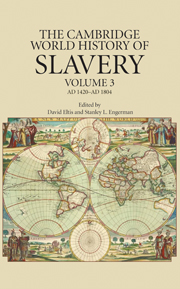Book contents
- Frontmatter
- Contents
- List of Maps, Figures, and Tables
- Contributors
- Series Editors' Introduction
- 1 Dependence, Servility, and Coerced Labor in Time and Space
- PART I SLAVERY IN AFRICA AND ASIA MINOR
- PART II SLAVERY IN ASIA
- 7 Slavery in Southeast Asia, 1420–1804
- 8 Slavery in Early Modern China
- PART III SLAVERY AMONG THE INDIGENOUS AMERICANS
- PART IV SLAVERY AND SERFDOM IN EASTERN EUROPE
- PART V SLAVERY IN THE AMERICAS
- PART VI CULTURAL AND DEMOGRAPHIC PATTERNS IN THE AMERICAS
- PART VII LEGAL STRUCTURES, ECONOMICS, AND THE MOVEMENT OF COERCED PEOPLES IN THE ATLANTIC WORLD
- PART VIII SLAVERY AND RESISTANCE
- Index
7 - Slavery in Southeast Asia, 1420–1804
from PART II - SLAVERY IN ASIA
Published online by Cambridge University Press: 28 September 2011
- Frontmatter
- Contents
- List of Maps, Figures, and Tables
- Contributors
- Series Editors' Introduction
- 1 Dependence, Servility, and Coerced Labor in Time and Space
- PART I SLAVERY IN AFRICA AND ASIA MINOR
- PART II SLAVERY IN ASIA
- 7 Slavery in Southeast Asia, 1420–1804
- 8 Slavery in Early Modern China
- PART III SLAVERY AMONG THE INDIGENOUS AMERICANS
- PART IV SLAVERY AND SERFDOM IN EASTERN EUROPE
- PART V SLAVERY IN THE AMERICAS
- PART VI CULTURAL AND DEMOGRAPHIC PATTERNS IN THE AMERICAS
- PART VII LEGAL STRUCTURES, ECONOMICS, AND THE MOVEMENT OF COERCED PEOPLES IN THE ATLANTIC WORLD
- PART VIII SLAVERY AND RESISTANCE
- Index
Summary
INTRODUCTION
Concepts of Slavery in Southeast Asia and Problems of Definition
The concept of Southeast Asia as a distinct regional entity has been debated by historians for several decades. Indonesia's national motto, “Unity in Diversity,” could well be applied to Southeast Asia as a whole. The historical analysis of slavery in Southeast Asia can contribute to this debate because general patterns of slavery and bondage seem to apply across this broad region. From the fifteenth to the end of the eighteenth century, the institution exhibits similar patterns, albeit with distinctive and important local variations. Modern Southeast Asia incorporates Myanmar (Burma), Thailand, Malaysia, Cambodia, Laos, Vietnam, Indonesia, and the Philippines. Sinicized (Chinese-influenced) Vietnam and the Hispanized Philippines have been included in the analysis of Southeast Asia on the basis of shared precolonial structures and historical trends. All these societies were characterized by bilateral kinship, relatively high status for women, wealth in people rather than land, strictly hierarchical social relationships, low population densities, highly personalized concepts of power, relatively fluid ethnic definitions in the period before large-scale state formation (around the seventeenth century), and complex local and regional trading patterns. Such social features have implications for the definition of relationships of bondage and dependency. As a field of study, Southeast Asian slavery is still coming into focus, and the purpose of this chapter is to outline some of the main elements and questions rather than provide a definitive discussion.
- Type
- Chapter
- Information
- The Cambridge World History of Slavery , pp. 163 - 185Publisher: Cambridge University PressPrint publication year: 2011
- 5
- Cited by

